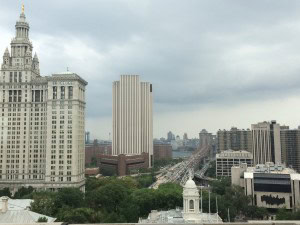Last spring Nisha Agarwal, the New York City commissioner on immigration, spoke to my students at Columbia University on the recent history of immigrants in New York City. As she detailed the services the Mayor’s Office of Immigrant Affairs (MOIA) provides today, she mentioned her office had been expanding rapidly over the past few months to accommodate President Obama’s executive actions on immigration. A growing office working on exactly the issues I care about most? Surely they needed a soon-to-be PhD in history specializing in immigration and politics. I raised my hand to ask who she was hiring. Lawyers and multilingual activists. Her statement confirmed the problems I faced thinking about career diversity. I had no idea how an organization could use my expertise (actually, I had no idea what my expertise was), or how to convince someone to hire me.
Fortunately, offering myself as free labor to MOIA helped with the second problem. With a grant from Columbia’s History in Action program, I decided to dedicate a significant portion of my summer to figuring out the first question—how could I translate a historian’s talents into work in public policy and outreach? Choosing the new coalition’s website design? Not my strength. Data input? As boring as it sounds. Cold-calling mayors to talk about immigration? Terrifying at first, but, with practice and coaching, ended up being fun. The areas where I thrived were, not surprisingly, the ones using the skills of a graduate student and dissertation writer: research, analysis, writing, and editing.
My biggest project at MOIA was recruiting new mayors—Republican or Democrat—to Cities United for Immigration Action, a national coalition of mayors supporting comprehensive immigration reform. In the world of academia, my specialty is Italian American ethnic politics of the Great Depression and World War II. In the real world, that’s not a widely recognized specialty, but potential employers could use the skills I developed gaining that knowledge. I spent the past three years poring over whitewashed sources to find hidden indicators of Fascist influences in America, developing major conclusions from scraps of evidence. At MOIA, I similarly sifted through massive amounts of data to find hidden clues about how to recruit people to our cause who had never spoken publicly on immigration, which I used to develop strategy for building the coalition. Like archival work, the payoff was slow and the legwork sometimes tedious. Still, I felt proud whenever we brought a new mayor into our coalition, knowing that because of my work that town now had access to New York City’s resources and experience in immigration advocacy. We could help them launch a municipal ID program, organize Citizenship Day actions, and add their voices to a national conversation about America’s immigrants.
The MOIA team set a goal of reaching 100 mayors by the end of August. In addition to that, I also needed to write a chapter of my dissertation, prepare my application materials for the academic job market, and develop the syllabus for a new class I started teaching this fall. My time at MOIA taught me the somewhat obvious lesson that researching and writing are translatable and useful skills for finding meaningful work in any field. As I tried balancing my responsibilities to my dissertation, teaching, and the internship that month, I also began noticing a problem in our approach to career diversity: as long as we continue to think of nonacademic work as part-time or extracurricular, it will always be treated as secondary to academia. This is a problem when we consider current trends in the academic job market, and we need to rethink how this work fits into a graduate education. I joined MOIA knowing I could not finish the last chapter of my dissertation before the fall if I did so. I gambled on the hopes that the experience would be worth it, even if not finishing my dissertation meant applying for academic jobs as a weaker candidate. The grant from History in Action helped make that decision slightly easier, but it was not enough to replace other teaching jobs, nor could it add extra days to the month of August.
Right now, we are pushing students to get through graduate school faster as we simultaneously ask them to train themselves for two different career paths. To best prepare future graduate students, we need to stop thinking of these careers as separate, rethink our educational priorities, and change our funding and program structures to meet these goals. Fitting an internship into the graduate school timeline should not be a gamble for students, and if we’re serious about career diversity, we need to incorporate internships as a foundational part of students’ education.
This post first appeared on AHA Today.
Jessica Lee is a doctoral candidate at Columbia University. Her dissertation examines the concurrent rise of Fascist nationalism and Italian Americans’ political capital during the Great Depression. Jessica also runs a college preparatory program for New York public school students through Columbia’s Center for American Studies and gives historic walking tours of New York City.
This work is licensed under a Creative Commons Attribution-NonCommercial-NoDerivatives 4.0 International License. Attribution must provide author name, article title, Perspectives on History, date of publication, and a link to this page. This license applies only to the article, not to text or images used here by permission.




